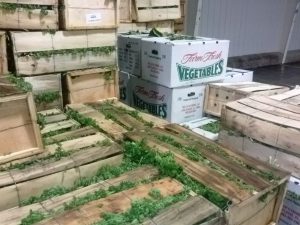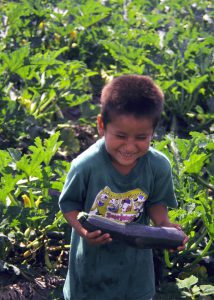Who’s growing your food?
It is important to many consumers to know who is growing their food. The country or state of origin may impact the freshness of your produce. It may also have an impact on the ripeness of the produce. Some produce like tomatoes, are picked early and then gassed with ethylene to speed up ripening once they are at the final shipping destination. This process may not be optimal for things like taste and quality. Others are concerned about the safety of food and whether they feel the suppliers are working within the boundaries of laws and labeling.

Challenges of large farms
Agricultural practices on a large commercial scale can be challenging to farmers. Unlike the homeowner, they must spray more often to stay ahead of pests and disease while the home gardener can take a different approach to pest control. Spraying can often be avoided by monitoring the levels of certain pests. Also, growing at home allows you to know what types of sprays have been used and when those applications were made.
Growing Organic
Because organic pesticides are from natural sources and break down quickly under normal environmental conditions, large commercial organic farmers often need to spray more frequently than traditional non-organic farmers. While organic pesticides are more environmentally friendly, they still have toxicities needed to control insects and other pests. When using them at home, always follow the label. You should treat them with the same precautions that you do traditional pesticides.
Growing your own

The answer to assuring how the vegetables you consume are grown,is to grow them yourself. To grow your food is to know your food. There is nothing fresher than a head of lettuce cut from your garden or picking your own vine ripe tomatoes. While the learning curve may seem long and tedious, the rewards can be substantial. There is no time like the present to start learning how to garden at home.
January 15th I will be offering a vegetable gardening class. The class will include a 100-page booklet with lots of good information to help get you started on your vegetable gardening adventure. You’ll learn about timing of when to plant different vegetables and how to overcome some of the unique challenges of Florida gardening. For information or to register for the class, click here.
That’s what’s new from the Hometown Gardener. “Like” and “Follow” me on Facebook at Hometown Gardener
Read my other blogs by clicking here.
In Highlands County, our office is at 4509 W George Blvd., Sebring. The Master Gardener Help Desk is open M – F from 9 AM to 3:30 PM. Subscribe to our Highlands County Master Gardener Volunteer newsletter, “Putting Down Roots”, by clicking here. Join our Facebook groups: Highlands County Master Gardeners, Heartland Beekeepers, Central Florida Butterfly, and Pollinator Club, and Science-Based Florida Gardening Answers
 0
0

Comments are closed.